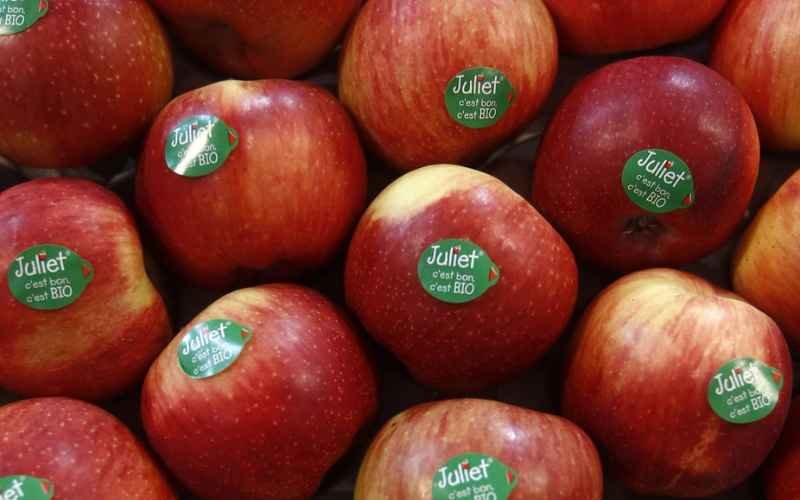When you walk through the produce aisle in your local grocery store, you’ll likely notice that almost every apple has a small sticker on it. While these stickers might seem like a minor detail, they actually carry significant information that can benefit you as a consumer. Here’s why these little labels are more important than you might think.

The Purpose of Apple Stickers
- Product Information: Each sticker typically contains a Price Look-Up (PLU) code, which helps both consumers and cashiers identify the type of apple and its price. This code can tell you whether the apple is organic, conventionally grown, or genetically modified.
- Quality Control: Stickers often include the brand name or the farm where the apple was grown. This helps in tracking the source of the fruit, ensuring better quality control and accountability from producers.
- Food Safety: In case of a foodborne illness outbreak, these stickers are crucial for tracing the origin of the fruit. This traceability can lead to faster recalls and better management of food safety issues.
Understanding PLU Codes
The PLU code on the sticker is a key piece of information. Here’s how to decode it:
- Four-digit code: Conventionally grown apples usually have a four-digit PLU code. For example, 4131 is the code for a Fuji apple.
- Five-digit code beginning with 9: If the code starts with a 9, the apple is organic. For example, 94131 is an organic Fuji apple.
- Five-digit code beginning with 8: This indicates the apple is genetically modified. However, this practice is less common, and you’ll rarely see these stickers.
Benefits of Knowing What the Sticker Means
- Healthier Choices: By understanding these codes, you can make more informed choices about the apples you buy, especially if you prefer organic produce.
- Supporting Practices You Believe In: Knowing whether an apple is organically grown or not can help you support farming practices that align with your values.
- Food Safety and Recalls: In the rare event of a recall, being able to identify the source of your apples can help you avoid potential health risks.
Removing the Sticker
Although these stickers are edible and generally non-toxic, it’s best to remove them before eating the apple. Here’s how to do it effectively:
- Peel off Gently: Use your fingernail to lift one edge of the sticker and gently peel it off.
- Wash the Apple: After removing the sticker, wash the apple thoroughly to remove any adhesive residue.
Conclusion
Next time you pick up an apple, take a closer look at the sticker. These tiny labels hold valuable information that can help you make healthier choices and support sustainable farming practices. Understanding what the codes mean can put you at an advantage, making your shopping experience both informative and beneficial. So, the next time you see that sticker, you’ll know it’s more than just a barcode—it’s a key to making smarter, more informed decisions about the food you eat.
Top 20 FAQs about Apple Stickers
1. What information is on an apple sticker?
The sticker typically includes a Price Look-Up (PLU) code, which indicates how the apple was grown (conventional, organic, or genetically modified), and sometimes the brand or farm name.
2. What is a PLU code?
A PLU (Price Look-Up) code is a numerical code used to identify the type and price of produce. It helps in distinguishing between different varieties and growing methods.
3. What does a four-digit PLU code mean?
A four-digit code (e.g., 4131) indicates that the apple was grown conventionally using standard agricultural practices.
4. What does a five-digit PLU code starting with 9 mean?
A five-digit code starting with 9 (e.g., 94131) indicates that the apple is organically grown.
5. What does a five-digit PLU code starting with 8 mean?
A five-digit code starting with 8 (e.g., 84131) signifies that the apple is genetically modified, though these are less common.
6. Are apple stickers safe to eat?
Yes, apple stickers are made from food-grade materials and are non-toxic, but it’s best to remove them before consuming the apple.
7. Why should I remove the apple sticker?
Removing the sticker ensures you don’t ingest any adhesive residue and helps in better cleaning of the apple’s surface.
8. Do apple stickers affect the taste of the fruit?
No, the stickers do not affect the taste or quality of the fruit.
9. Can the stickers be composted?
Most stickers are not compostable as they are made from plastic or other non-biodegradable materials.
10. Why are some apples without stickers?
Apples without stickers might come from smaller farms that don’t use them, or they might have been removed during handling.
11. How do I read the PLU code if it’s smudged or missing?
If the PLU code is unreadable, you can ask the store staff for assistance, as they usually have the information for their produce.
12. What if I can’t find organic apples with a 9-code sticker?
Not all stores carry organic apples, and some may not use the PLU system correctly. Look for certified organic labels or sections in the store.
13. Do all fruits have PLU stickers?
Many types of produce have PLU stickers, not just apples. This system is common for various fruits and vegetables.
14. What should I do if I find a mislabeled apple?
If you find an apple with an incorrect or suspicious label, inform the store manager to ensure proper handling and accuracy.
15. How are PLU codes assigned?
PLU codes are assigned by the International Federation for Produce Standards (IFPS) and are used globally.
16. Why are some apples priced higher than others?
Organic apples and certain premium varieties might be priced higher due to the cost of production and certification processes.
17. Can I trust the information on the apple sticker?
Yes, apple stickers are regulated and provide accurate information regarding the type and growing method of the fruit.
18. Why do imported apples have different stickers?
Imported apples may have stickers with different designs or additional information specific to their country of origin.
19. What should I do if I prefer apples without stickers?
You can wash the apple thoroughly to remove any residue or buy from markets that sell sticker-free produce.
20. Can the stickers indicate the ripeness of the apple?
No, the stickers do not indicate ripeness. You should check for firmness, color, and aroma to determine if an apple is ripe.
Related posts:
 ICMR’s Dietary Guidelines Advocate Salt Intake Restriction for Indians
ICMR’s Dietary Guidelines Advocate Salt Intake Restriction for Indians
 Healthy Indian Breakfast Recipes: A Nutritious Start to Your Day
Healthy Indian Breakfast Recipes: A Nutritious Start to Your Day
 Khana Banane Ki Recipe: Quick and Easy Tips for Delicious Meals
Khana Banane Ki Recipe: Quick and Easy Tips for Delicious Meals
 Superfood Banana: Know THESE 5 Benefits of Kela
Superfood Banana: Know THESE 5 Benefits of Kela
 Ramadan 2024: 5 Essential Self-Care Practices to Enhance Your Well-being
Ramadan 2024: 5 Essential Self-Care Practices to Enhance Your Well-being
 Holi 2024: 5 Dietary Changes to Shed Pounds Before This Festive Season
Holi 2024: 5 Dietary Changes to Shed Pounds Before This Festive Season
 Healthy and Easy-to-Make Lunchbox Recipes for Kids
Healthy and Easy-to-Make Lunchbox Recipes for Kids
 Obesity: A Possible Contributor to Early Menarche in Girls
Obesity: A Possible Contributor to Early Menarche in Girls
 The Power of Eating a Banana Daily: A Comprehensive Guide
The Power of Eating a Banana Daily: A Comprehensive Guide






